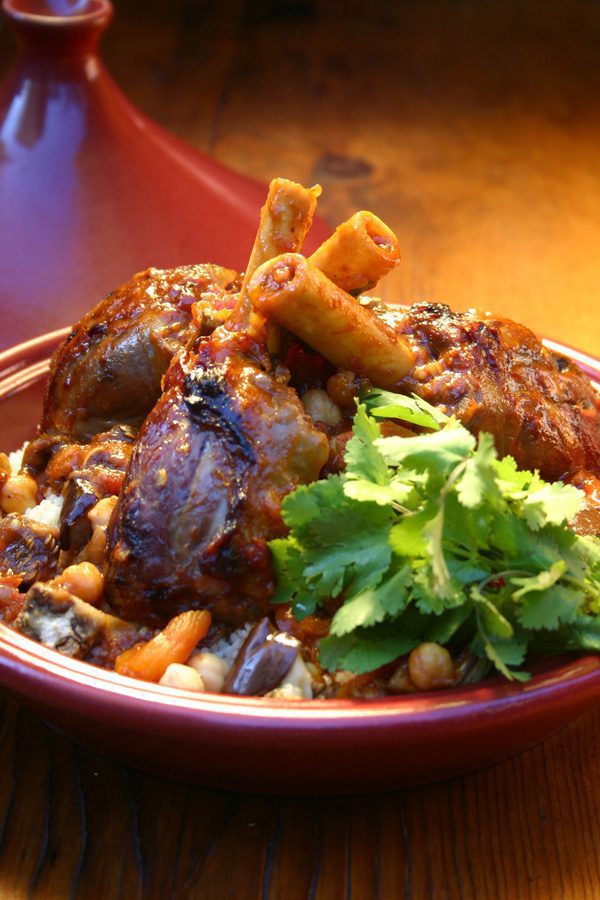I love this because you just put everything in the pot, turn on the heat and cook for 3 hours while you potter about. This Moroccan stew was traditionally made by working men in Marrakech who did not have anybody at home to cook for them while out all day. Everything went into a tall earthenware jar which was then topped with paper and tied with string and given a good shake to mix. The whole jar would be brought to the Hamam (public steam baths) before work, to be collected, ready to eat, in the evening. This recipe was shown to us by Sidi Mahommad in Marrakech – the only changes I have made are in adding onions and potatoes. If you are doing a ketogenic eating plan or wanting to lose weight simply omit anything that contains lots of carbohydrate (millet, potatoes, chickpeas) and serve with more green veggies.
For 4
4 lamb shanks, 500g of large chunky lean beef or lamb pieces or 4 large lamb gigot chops
2 heaped teaspoons ras el hanout*
2 teaspoons of ground cumin
3 large garlic cloves, peeled and roughly cut up in quarters
1 small or half a large preserved lemon*, rinsed and divided into 8 pieces (these are available from Halal shops and Asian store). Alternatively use the quartered skin of half an unwaxed, organic lemon – it won’t have the distinctive Morrocan flavour though
450g bag small onions or shallots, peeled
Fresh coriander leaves to garnish, if you have them.
Optional: 450g/2 large floury potatoes, peeled and halved
*You can make your own spice blend and preserved lemons by checking out the recipes for them on this blog.
1. Take a large heavy-bottomed saucepan or top-of-the-stove casserole dish with a lid and in it place lamb, spices, garlic, onions, potatoes and enough cold water so it covers the meat and veg by about 4cm.
2. Put the lid on and swill around gently to coat everything in the spices.
3. Simmer gently for 3 hours on the top of the stove
4. Garnish with lots of fresh coriander leaves if you have some. It’s still great without!
Serve with:
500g runner or green beans – either steamed or else cooked on top of the simmering tagine for 15 mins or so until tender.
Variations:
- Leave out the potato and instead serve with freshly cooked millet grain. (Cook 1 mug millet with 2 mugs of boiling water – it takes about 10 mins. If you fluff it up with a fork after cooking it should look quite like couscous). Garnished with a drizzle of olive oil and a sprinkling of ground paprika, it works brilliantly with most tagines.
- Instead of potatoes, add two mugfuls of chickpeas (soak 1 mugful overnight and boil rapidly for 15 mins first) to the meat at the beginning of cooking. That way they will take up a great flavour. Otherwise just add 2 tins of rinsed drained chickpeas to the tagine for the last 15 minutes of cooking.
Shortcut:
If you cant get preserved lemons then use unwaxed ORGANIC lemons – the peel of fruit has a lot of pesticides unless organic. It wont be exactly the same but still gives a good flavour.
Why this is good for you:
Stewing rather than browning your meat means it keeps its nutritional value. Browning any food leads to oxidation which damages the meat, and your body when you eat it. Avoiding browned foods helps you keepy our digestive system in tip top shape and delays skin (and other!) ageing. Spices are powerful antioxidants and it is more useful to have a wide variety of them than to focus narrowly on just one or two. Ras el hanout gives you a good range of vitality-boosting antioxidants. If you use cuts of meat that include bones these will fortify the broth with collagenous substances. This supports the essential daily repairs and maintenance of your gut (digestive system). Great news if you are trying to heal gastritis, ulcers, food intolerances or indeed almost any digestive disorder where the lining of your gut is inflamed or damaged.

